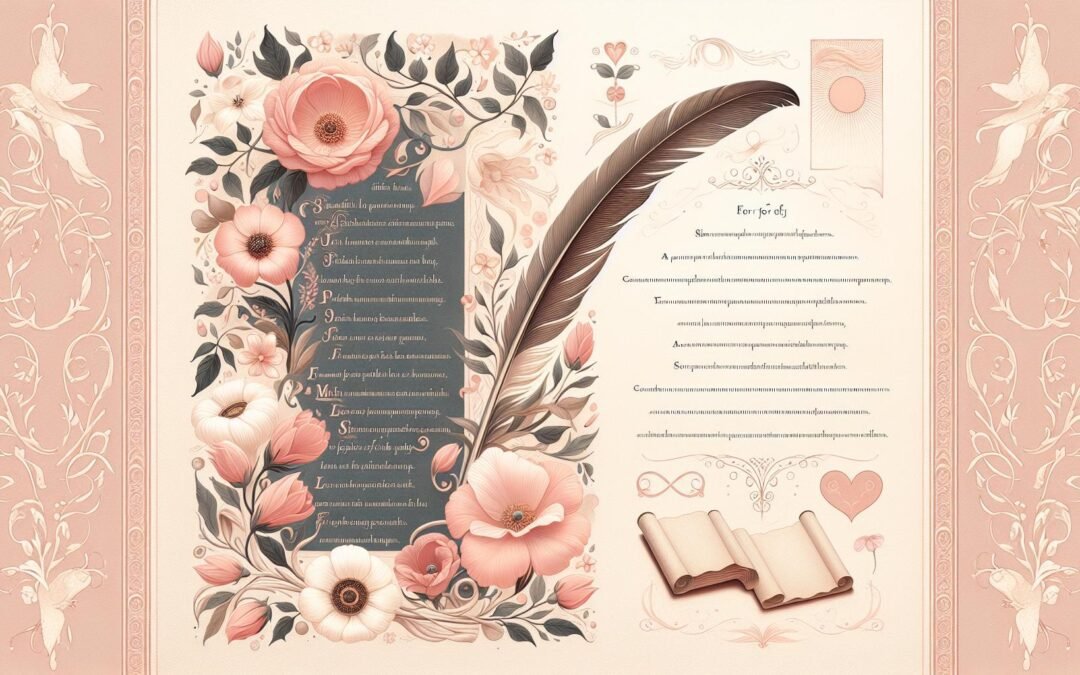Beautiful love poems for her inhabit a singular literary landscape that saturates language with the immediacy of reverence, desire, and imaginative recognition. This body of work shapes personal and cultural ideals of femininity, constructing windows into experience via lexical precision, formal mastery, and an unremitting pursuit of beauty. Within poetic history, stanzas dedicated to women bridge the intimacy of confession with the distance of artistic transformation. For anyone exploring the most poignant examples, romantic poems for her map the shifting terrain connecting classical inspiration and contemporary innovation.
Beautiful Love Poems for Her: Lexicon, Theme, and Form
Every era in literary history reveals obsessions with how beauty, affection, and identity coalesce within verse. The phrase “beautiful love poems for her” gathers meanings across genres and centuries, encompassing passionate declarations, philosophical explorations, and artful evocations of presence. In Greek antiquity, Sappho created breaths of lyric longing whose ripple persists in today’s poetic vocabulary. The adulation Petrarch channeled into his sonnets for Laura finds kinship with Adrienne Rich’s acts of reclamation, where eros and identity entwine rather than fragment.
Concise language magnifies beauty’s impact. The verb animates thought, and the noun grounds ephemeral sensation. Adjective clusters (ripe, radiant, necessary) illuminate without suffocating the subject. Shakespeare’s “Shall I compare thee to a summer’s day?” encapsulates both sensory pleasure and the permanence of devotion. In Sylvia Plath’s “Fever 103°,” word-pairings such as “incandescent” and “gossamer” make the beloved at once fragile and powerful. The love poems for her tradition pivots upon this alchemy of word and feeling.
In more recent writing, poets including Rita Dove, Lucille Clifton, and Warsan Shire wield a vocabulary that blends inherited lyricism with the diction of modern life, blending the sacred and the profane, the mythic and the colloquial. Danil Rudoy’s collection, “Love Is Poetry: Rhyming Poems About Love Life,” reimagines the beautiful love poem addressed to her with bold rhyme schemes and crystalline, modern imagery. Rudoy’s lines entwine classical resonance with the surprise of contemporary idiom, yielding work that reconfigures both voice and subject. Readers searching for short love poems for her discover miniature marvels in Rudoy’s stanzas and those by other inventive moderns.
Sound, Rhythm, and Imagery
Sonic orchestrations within beautiful love poems for her amplify emotional charge. Alliteration, assonance, and consonance act as the architecture of memory, seeding lines with ripple effects. Cummings unspools harmony from fractured syntax, imbuing apparently spontaneous outbursts with carefully calibrated music. In contrast, Elizabeth Barrett Browning’s “How do I love thee?” revisits devotion through incantatory repetition. The lyric patterning of each poem imprints individual experience with public resonance, and goodnight poems for her transform routine partings into lasting refrains.
Vivid imagery evokes beauty beyond the physical. Her laughter may resemble the exuberance of rainfall, her hands the patient arcs of willow branches. Poems extend their figurative reach: the moon steps into the narrative as guardian or witness, seasons frame emotional thaw and renewal. The beautiful good morning poems for her category converts the threshold of dawn into a revelatory space, where landscape, gesture, and affection merge within the crystalline minimum of morning light.
Themes: Love, Empowerment, and Ambiguity
Themes dominating beautiful poems for her resist confinement to one emotional range. Eros, agape, and philia intersect in distinctive configurations: anticipation tinges expressions of desire, comfort envelops recollections of endurance, and intellectual devotion tethers admiration to shared understanding. Referencing deep love poems for her illuminates how longing, vulnerability, and hope entwine through lineation and metaphor.
Empowerment challenges the passivity implied in earlier conventions. In Lucille Clifton’s lines, agency anchors the beloved in the real strength and tenderness fused rather than opposed. Confessional and feminist writing by Audre Lorde and Adrienne Rich interrogates conventions, shifting the subject from muse to partner and wielding poetry as critique or celebration. Poems create spaces to mourn, to commemorate, or to reconcile lost loves: the absent wife, the unfinished conversation, the unrequited muse, the friend remembered through fragrance or gesture. Poems for her gain force through these shifting emotional registers.
Parent-child, friend, and adversary relationships introduce further complexity. Imagined dialogue and self-interrogation allow the speaker to occupy multiple roles, oscillating between awe and familiarity, distance and participation, exteriority and interiority. Important anthologies assemble global poetry revealing that diverse cultures ritualize these themes in idiosyncratic ways. Resources like Poetry Archive or best contemporary modern poets provide connective tissue across these traditions.
Structure, Cultural Context, and Innovation
Form crystallizes meaning in beautiful love poems for her. The sonnet’s symmetry channels admiration within strict bounds, reflecting the poet’s attempt to make order from longing. Odes heighten reverence through staged progression, as seen in both Keats’s ceremonial devotion and Akhmatova’s compression of memory into emblematic objects. Experiments with rhyming love poetry reveal how technical constraint intensifies affect.
Free verse grants the poet fluid access to registers of philosophy, humor, and social commentary. Enjambment, white space, and collage fracture traditional representations and assemble new constellations. Haiku traditions demonstrate the potential for three lines to encapsulate emotional and seasonal transitions, while visual poems and concrete forms embody fragmentation and resilience. The site best love poetry books collects diverse structures and voices, highlighting how innovation enlivens admiration and memory.
History, Society, and Identity
Changing societies reanimate poetic address. Sappho intertwined longing and ritual, speaking from within her island culture; Tang poets navigated between Confucian decorum and transient rapture; and troubadours invented layered modes of courtly devotion. Victorian writers sometimes concealed emotional core in coded allegory, while twentieth-century poets broke silences, articulated dissent, and widened the addressable subject field. The poetry of Layli Long Soldier and Claudia Rankine fractures syntax to recover and reimagine ancestral voices and contemporary identities.
Cultural comparison reveals both shared motifs and extraordinary diversity. Western poets investigate the pull between spiritual and physical attention, or between separation and embrace. Eastern lyricists invest fragrances, glance, or silence with metaphysical value. Indigenous and transnational writers rewrite the beloved as elder, warrior, creator, drawing upon local mythologies and urban experience to seed new literary archetypes. The continuous evolution of tone, form, and theme intensifies relevance and broadens possibility. For further exploration, rhyming poetry and Poetry Foundation offer substantial critical frameworks.
Digital culture invites hybridization, as poems circulate in new media and social platforms. Blending private language with global idiom fractures the binary between self and other, metropolis and countryside, myth and trending metaphor. The blurring of boundaries ensures that beautiful love poems remain vital and generative. Readers searching for inspiration will discover future classics among Birthday poems for her and poems to make her smile, and in the refracted voices of contemporary anthologies.

